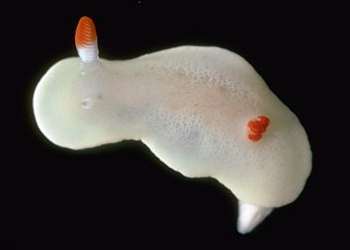
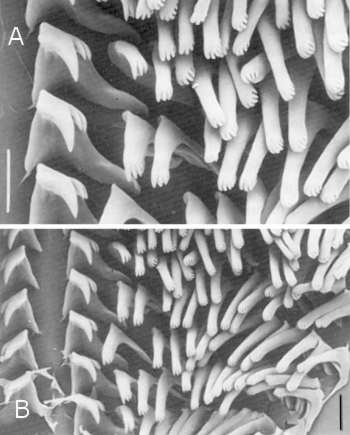
Noumea verconiforma
Rudman, 1995
Order: NUDIBRANCHIA
Suborder: DORIDINA
Superfamily: EUDORIDOIDEA
Family: Chromodorididae
DISTRIBUTION
New Caledonia, eastern Australia [sthn Queensland]
PHOTO
Upper: NW side of Récif de l'Infernet, 20 35.8'S, 164 12.7'E, 9-10m, in Lagoon, off Koumac, New Caledonia, HOLOTYPE, 6mm long alive, 15 October 1993, AM C200499 (in MNHN, Paris). Photo: Bill Rudman. Lower: Scanning electron micrographs of radula. A, Teeth 1-9 on right side. B, Section of radula showing central region and right side. Scale bar = 20 µm in all cases. Photo: A.C. Miller.
The mantle is translucent white with a reticulate pattern of opaque white, which gives a sponge-like appearance to the mantle, similar to that of Verconia. Around the edge is a thin band of opaque white. The mantle glands are not visible in the living animal. The rhinophore stalk is translucent clear, while the lower third of the rhinophore club is opaque white and the upper two-thirds bright orange-red. The gills are translucent white with a bright orange-red edge to the upper two-thirds of each gill. The gill lamellae in upper third of each gill (upper 3-4 lamellae) are also line with orange-red.
The underside of mantle, body and foot are all translucent white.
The mantle is ovate with a relatively broad mantle overlap. Approximately midway down each side the mantle edge folds out. This lateral 'widening' of the mantle is semi-permanent and gives this species, and others which also exhibit this feature, a cross-like appearance. The mantle glands are large, single opaque spheres, easily visible in the preserved specimen. They form an irregular band (of approx 15 glands) around the mantle skirt. There are seven simple gills which vibrate rhythmically. The radular formula of the holotype is 14 + 1.0.1 + 14 x 22, and like most in the genus the innermost lateral tooth on each side is wide and triangular, quite different from the other lateral teeth which are elongate, with a few terminal denticles.
-
Rudman, W.B. (1995) The Chromodorididae (Opisthobranchia: Mollusca) of the Indo-West Pacific: further species from New Caledonia and the Noumea romeri colour group. Molluscan Research, 16: 1-43.
Rudman, W.B., 2005 (February 1) Noumea verconiforma Rudman, 1995. [In] Sea Slug Forum. Australian Museum, Sydney. Available from http://www.seaslugforum.net/find/noumverc
Related messages
Re: Noumea verconiforma? from South Africa
November 21, 2008
From: Scott Johnson
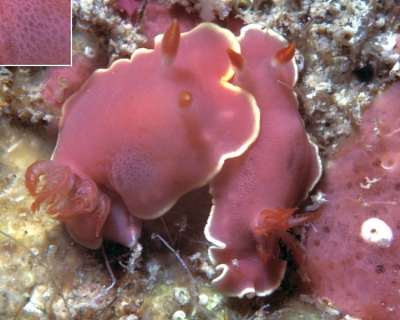
Concerning message #22031:
Hi Bill,
I hadn't picked up on this until you posted Colin Ogden's photo from South Africa, but I think one of my unidentifieds from the Marshalls might be your Noumea verconiforma. Attached are three shots of two specimens found on the same reef but not together (in fact, they were found on successive days and put together for the photo). Both were on the pink sponge visible in the photos. The image of the single individual shows it in its original position under a rock at a depth of 5 meters on 5 September 1983. The next day, when I took the first animal back out to take more photos, I found the second, smaller one on the pink sponge colony in the two photos that show both specimens. My radula drawings show teeth very similar to your SEMs on the fact sheet, particular the shape and denticulation of the wide innermost tooth. The larger animal measured 11 x 6 mm at rest and 16 x 5 mm stretched out and crawling, while the smaller was 9 x 5 mm. It is always a treat to get a probable id for a long-term puzzle.
Locality: Enewetak Atoll, 2-5m, Marshall Islands, Pacific, 5 and 6 September 1983, Under rocks on shallow reef. Length: 9 to 16mm. Photographer: Scott Johnson.
There are a couple of different photos and a bit more information at http://www.underwaterkwaj.com/nudi/chromodorids/e363.htm on the Marshall Islands sea slug web site.
Thanks,
Scott
uwkwaj@yahoo.com
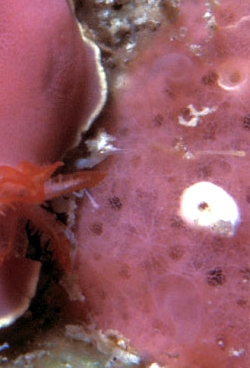
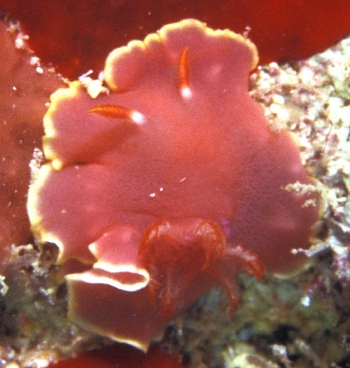
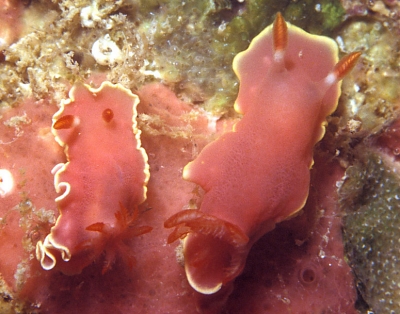
Dear Scott,
Thanks for these. I can't say I have solved your puzzle because I am not 100% convinced they are all N. verconiforma. Certainly the reticulate pattern on the mantle, reminiscent of a fibrous sponge, links them all together, but it may just be that several species have evolved the same camouflage strategy as their namesake Verconia verconis.
Having said that, your photos show traces of the large ovate, opaque white, mantle glands forming a spaced row around the mantle skirt some distance from the edge. My original specimen, and all the other 'possibles' on the Forum have that same arrangement.
The pink sponge, which looks like a darwinellid, would seem to be its food. I'll get its identification checked.
Best wishes,
Bill Rudman
Noumea verconiforma? from South Africa
November 14, 2008
From: Colin Ogden
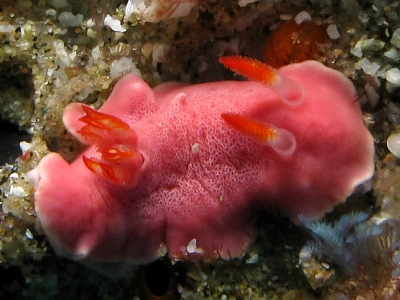
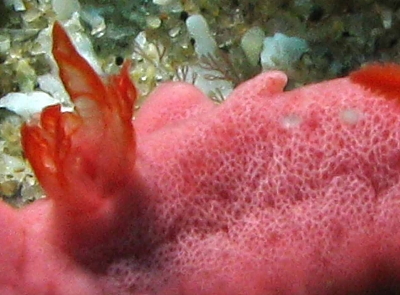
Concerning message #19433:
Hi Bill,
I have another Nudi that has me confused. I have never seen anything with this colour before, but its shape and also the white with red rhinopores and gills remind me of the Diversidoris aurationodulosa that I have found here only twice before. I would appreciate your thoughts on this.
Locality: Sodwana Bay, 14 metres, South Africa, Indian, 2 November 2008, Coral Reef. Length: 30mm. Photographer: Colin Ogden.
Regards
Colin
scubaco@iafrica.com
Ogden C. M., 2008 (Nov 14) Noumea verconiforma? from South Africa. [Message in] Sea Slug Forum. Australian Museum, Sydney. Available from http://www.seaslugforum.net/find/22031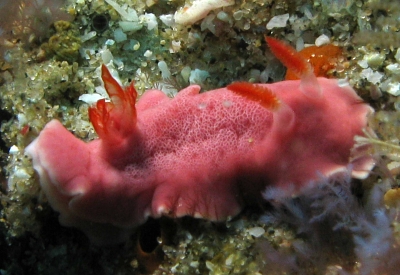
Dear Colin,
The closest I can get to a name is Noumea verconiforma. It has not been found outside the southwest Pacific before, but its colour and reticulate pattern, which looks like the texture of a fibrous sponge, are very similar. However it is much larger than any specimen found before. Without knowing anything of its anatomy I can't say much more, but I think I will leave it as a 'possible Noumea verconiforma' rather than start a new page for it.
Best wishes,
Bill Rudman
Noumea verconiforma from Heron Island
August 30, 2007
From: Julie Marshall
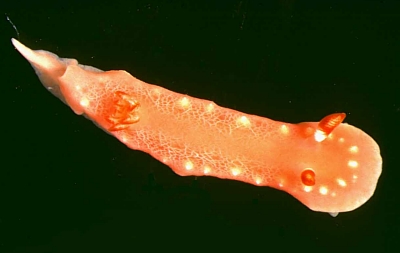
Dear Bill,
Attached is a photo of what seems to be Noumea verconiforma from Heron Island [Great Barrier Reef]. As the original description of this species was based on a single animal from New Caledonia it seems likely that there would be some intraspecific variation. The animal I found was coral pink in colour but has the reticulate pattern of opaque white on the mantle as described in your paper. The rhinophores and gills also match the description of N. verconiforma. The major difference is the distinct submarginal single mantle glands on the Heron Island animal.
Locality: Heron Island, 11m, Queensland, Australia, Pacific, November 1997, Subtidal. Length: 10 mm. Photographer: Julie Marshall.
I think this is the first record for this species beyond New Caledonia, and also for Australia. It was illustrated as Noumea sp. 1 in Marshall and Willan (1999).
-
Marshall, J.G. and Willan, R.C. 1999. Nudibranchs of Heron Island., Great Barrier Reef. Leiden, Backhuys Publishers.
Best wishes,
Julie Marshall
juliemarshall@netspace.net.au
Marshall, J., 2007 (Aug 30) Noumea verconiforma from Heron Island. [Message in] Sea Slug Forum. Australian Museum, Sydney. Available from http://www.seaslugforum.net/find/20586Dear Julie,
I was just preparing a message from Gary Cobb [#20577] about his find of this species in sthn Queensland, when your message arrived - it's either a remarkable co-incidence or perhaps you and Gary and Richard Willan have been doing a bit of networking? The Atkinson's Chromodorid sp. 1 is probably the same thing, and I have found it a few times in northern New South Wales. I have dissected specimens and when I get a minute I must see why I was hesitant to identify it as N. verconiforma.
My only doubt about the identityof your animal is that Noumea verconiforma wriggled or vibrated its gills backwards and forwards in a regular way, yet you state in your book that your animal did not do that.
Best wishes,
Bill Rudman
Noumea verconiforma found in sthn Queensland
August 30, 2007
From: Gary Cobb
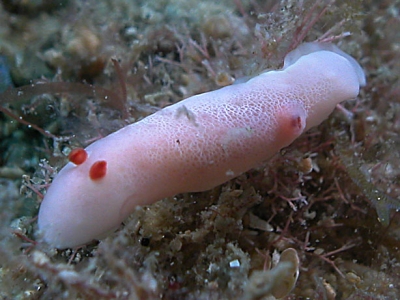
Hi Bill and everyone!
Well yet again Old Woman Island continues to produce nudibranchs when you least expect them! Noumea verconiforma was photographed by David Mullins my dive buddy and I at the eastern end of the Wall. Thinking it was a common Noumea simplex we didn't think any more about it. Then David was going thru the photos and found this! Great surprise...our 316th species here on the Sunshine Coast.
Locality: Old Woman Island, Sunshine Coast, 12m, Queensland, Australia, Pacific Ocean, 27 August 2006, Subtidal. Length: 10mm. Photographer: Gary Cobb and David Mullins.
I also noticed there were no entries for this species on the Forum!
Cheers,
Gary Cobb
gary@nudibranch.com.au
Cobb, G.C., 2007 (Aug 30) Noumea verconiforma found in sthn Queensland. [Message in] Sea Slug Forum. Australian Museum, Sydney. Available from http://www.seaslugforum.net/find/20577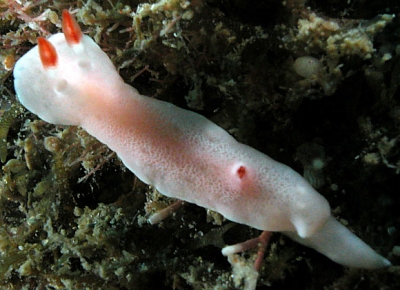
Dear Gary,
Thanks for this nice addition to the Forum. This seems to be another of those species found in the Coral Sea triangle between New Caledonia, Lord Howe Is and the eastern Australian coastline.
I suppose it's too much to ask if you can remember whether it wriggled its gills backwards and forwards in a rhythmic way?
Best wishes,
Bill Rudman
